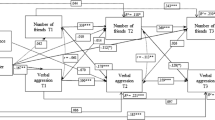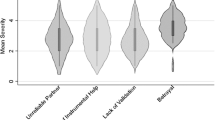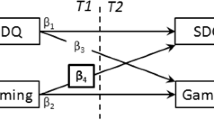Abstract
This observational study supplements the strong and consistent link found between childhood depression and deficits in interpersonal functioning by examining the relationship between a high versus low score on the Children’s Depression Inventory (CDI) and children’s emotions when interacting with their best friends. High-CDI and low-CDI target children (n=86) were paired for videotaped game-playing with self-reported best friends. Researchers found that although high-CDI target children were not distinguishable from low-CDI peers in their displays of positive and negative emotion. However, the partners of high-CDI target children displayed significantly more negative emotion during the competitive task and significantly less positive emotion during the cooperative task than did partners of low-CDI target children. In addition, high-CDI target children and their partners reported less enjoyment of their interactions than low-CDI target children and their partners. This combination of findings suggests that depressive symptoms were associated with a relative lack of success achieving an optimal friendship interaction even under highly favorable conditions.
Similar content being viewed by others
References
Allen, E., Hoye, W., Blakely, B., & Rholes, W. (1995). Friendship and peer group acceptance: Relationships with depressive symptoms in middle childhood. Paper presented at the Society for Research in Child Development, Indianapolis, IN.
Altmann, E. O., & Gotlib, I. H. (1988). The social behavior of depressed children: An observational study. Journal of Abnormal Child Psychology, 16, 29–44.
Asher, S., Parker, J., & Walker, D. (1996). Distinguishing friendship from acceptance: Implications for intervention and assessment. In A. F. N. W. W. H. W. M. Bukowski (Ed.), The company they keep: Friendship in childhood and adolescence. New York, NY: Cambridge University Press.
Baker, M., Milich, R., & Manolis, M. B. (1996). Peer interactions of dysphoric adolescents. Journal of Abnormal Child Psychology, 24, 241–255.
Belsher, G., & Costello, C. G. (1991). Do confidants of depressed women provide less social support than confidants of nondepressed women? Journal of Abnormal Psychology, 100(4), 516–525.
Berndt, T., Hawkins, J., & Jiao, Z. (1999). Influences of friends and friendships on adjustment to junior high school. Merrill Palmer Q, 45(1), 13–41.
Blechman, E. A., McEnroe, M. J., Carella, E. T., & Audette, D. P. (1986). Childhood competence and depression. Journal of Abnormal Psychology, 95, 223–227.
Boivin, M., Hymel, S., & Hodges, E. (2001). Towards a process view of peer rejection and harrassment. In J. Juvonen & S. Graham (Eds.), Peer harrassment at school: The plight of the vulnerable and victimized (pp. 265–289). New York, NY: Guilford Press.
Bukowski, A. L., & Hoza, B. (1989). Popularity and friendship: issues in theory, measurement, and outcome. In T. Berndt & G. Ladd (Eds.), Peer relationships in child development (pp. 15–45). New York, NY: Wiley.
Cohen, J. (1992). A power primer. Psychological Bulletin, 112, 155–159.
Cole, D. A. (1990). Relation of social and academic competence to depressive symptoms in childhood. Journal of Abnormal Psychology, 99, 422–429.
Cole, D. A., & Carpentieri, S. (1990). Social status and the comorbidity of child depression and conduct disorder. Journal of Consulting and Clinical Psychology, 58, 748–757.
Crick, N. R., & Grotpeter, J. K. (1995). Relational aggression, gender, and social-psychological adjustment. Child Development, 66(3), 710–722.
Fahl, M. A. (1970). Emotionally disturbed children: effects of cooperative and competitive activity on peer interaction. American Journal of Occupational Therapy, 24(1), 31–33.
Fombonne, E., Wostear, G., Cooper, V., Harrington, R., & Rutter, M. (2001). The Maudsley long-term follow-up of child and adolescent depression. 1. Psychiatric outcomes in adulthood. The British Journal of Psychiatry, 179, 210–217.
Furman, W. (1984). Issues in the assessment of social skills of normal and handicapped children. In J. L. R. T. Field & M. Segal (Eds.), Friendships in normal and handicapped children (pp. 3–30). Norwood, NJ: Ablex Publishing.
Garber, J., Kriss, M. R., Koch, M., & Lindholm, L. (1988). Recurrent depression in adolescents: a follow-up study. Journal of the American Academy of Child and Adolescent, 27(1), 49–54.
Gelb, R., & Jacobson, J. (1988). Popular and unpopular children’s interactions during competitive and cooperative peer group activities. Journal of Abnormal Child Psychology, 16, 247–261.
Harrington, R. (1990). Depressive disorder in children and adolescents. British Journal of Hospital Medicine, 43(2), 108, 110, 112.
Harrington, R., Fudge, H., Rutter, M., Pickles, A., & Hill, J. (1990). Adult outcomes of childhood and adolescent depression. I. Psychiatric status. Archive of General Psychiatry, 47(5), 465–473.
Hartup, W. W. (1993). Adolescents and their friends. In B. Laursen (Ed.), Close friendships in adolescence (pp. 3–22). San Francisco: Jossey-Bass.
Heller, M. C., Sobel, M., & Tanaka-Matsumi, J. (1996). A functional analysis of verbal interactions of drug-exposed children and their mothers: the utility of sequential analysis. Journal of Clinical Psychology, 52(6), 687–697.
Hops, H., Biglan, A., Sherman, L., Arthur, J., Friedman, L., & Osteen, V. (1987). Home observations of family interactions of depressed women. Journal of Consulting and Clinical Psychology, 55, 341–346.
Hops, H., Biglan, A., Tolman, A., Arthur, J., & Longoria, N. (1995). Living In Family Environments (LIFE) coding system (Rev. ed.). Eugene, OR: Oregon Research Institute.
Jacobsen, R. H., Lahey, B. B., & Strauss, C. C. (1983). Correlates of depressed mood in normal children. Journal of Abnormal Child Psychology, 11, 29–39.
Kazdin, A., Sherick, R., Esveldt-Dawson, K., & Rancurello, M. (1985). Nonverbal behavior and childhood depression. Journal of the American Academy of Child and Adolescent Psychiatry, 24, 303–309.
Kovacs, M. (1982). Child Depression Inventory. Toronto, Canada: Multi-Health Systems, Inc.
Kovacs, M., Feinberg, T. L., Crouse-Novak, M. A., Paulauskas, S. L., & Finkelstein, R. (1984). Depressive disorders in childhood. I. A longitudinal prospective study of characteristics and recovery. Archive of General Psychiatry, 41(3), 229–237.
Locke, K. D., & Horowitz, L. M. (1990). Satisfaction in interpersonal interactions as a function of similarity in level of dysphoria. Journal of Personality and Social Psychology, 58, 823–831.
Panak, W. F., & Garber, J. (1992). Role of agression, rejections, and attributions in the prediction of depression in children. Development and Psychopathology, 4, 145–165.
Parker, J. G., & Asher, S. R. (1993). Friendship and friendship quality in middle childhood: Links with peer group acceptance and feelings of loneliness and social dissatisfaction. Development and Psychopathology, 29, 611–621.
Rockhill, C. M. (1999, April 15). Depression and friendship reciprocity: Relation of congruence in perception about positive friendship qualities. Paper presented at the Society for Research in Child Development, Albequerque, NM.
Rockhill, C. M. (2000). Depressed children’s friendships. Dissertation Abstracts International, 61(5-B), 2798. (UMI No. 9971179).
Rockhill, C. M., Fan, M., McCauley, E., Katon, W., Crick, N. R., & Pleck, J. H. (2006). Perceived friendship qualities in depressed and nondepressed children’s reciprocal friendships. Under revision.
Rosenblatt, A., & Greenberg, J. (1991). Examining the world of the depressed: do depressed people prefer others who are depressed? Journal of Personality and Social Psychology, 60, 620–629.
Rudolph, K. D., & Clark, A. G. (2001). Conceptions of relationships in children with depressive and aggressive symptoms: social-cognitive distortion or reality? Journal of Abnormal Child Psychology, 29(1), 41–56.
Rudolph, K. D., Hammen, C., & Burge, D. (1994). Interpersonal functioning and depressive symptoms in childhood: addressing the issues of specificity and comorbidity. Journal of Abnormal Child Psychology, 22(3), 355–371.
Stats Indiana (2005). Accessed on December 30, 2005.
Timbremont, B., Braet, C., & Dreessen, L. (2004). Assessing depression in youth: relation between the Children’s Depression Inventory and a structured interview. Journal of Clinical and Child Adolescent Psychology, 33, 149–157.
United States Census Bureau (2000). State and County Quick Facts. Accessed on August 1, 2006.
Vernberg, E. M. (1990). Psychological adjustment and experiences with peers during early adolescence: reciprocal, incidental, or unidirectional relationships? Journal of Abnormal Child Psychology, 18, 187–198.
Acknowledgments
This research was supported by the following grants to the first author: Fahs-Beck Foundation Dissertation Completion Grant; Graduate College of the University of Illinois at Urbana-Champaign (UIUC) Dissertation Research Grant; University Fellowships from the Department of Human and Community Development and the Medical Scholars Program, UIUC; Hazel I. Craig Summer Research Fellowship, UIUC; Summer Graduate Research Grant from the College of Agricultural, Consumer, and Environmental Sciences, UIUC. We gratefully acknowledge the teachers and students who participated in this research, and thank Alison Sattler for her skillful assistance in preparing the manuscript.
Author information
Authors and Affiliations
Corresponding author
Rights and permissions
About this article
Cite this article
Rockhill, C.M., Fan, MY., Katon, W.J. et al. Friendship Interactions in Children with and without Depressive Symptoms: Observation of Emotion during Game-Playing Interactions and Post-Game Evaluations. J Abnorm Child Psychol 35, 429–441 (2007). https://doi.org/10.1007/s10802-007-9101-z
Received:
Accepted:
Published:
Issue Date:
DOI: https://doi.org/10.1007/s10802-007-9101-z




